Karina arrived last night. A whirlwind of enthusiasm and energy, ours is a friendship of opposites. We met when she enrolled her son at the school where I taught; and in time she became a member of staff herself. When the school closed our friendship continued to blossom. I like and admire her for her forthrightness, her spirited independence and her passion. Where I am reticent in revealing my feelings, Karina wears her heart on her sleeve and can be no other way. It was a joy to welcome her to Highfield.
Our first full day dawned dubiously. The weather seemed undecided. But we were walking, rain or shine. Although I’ve been walking locally, here was my chance to explore further afield. Karina provided the enthusiasm and the confidence to strike out.
I wanted to do the Hall Walk – a famous local route which takes in views of Fowey, along peaceful riverbanks and through tranquil woods. It’s a circular walk of about 4 miles, using both ferries to take in Fowey and return to the starting point. “I thought maybe we could add a little more on Fowey side,” I suggested. I think even then I knew that the Hall Walk alone was not going to be enough. “Good idea,” said Karina as she studied the directions. “And let’s add this loop.” I looked to where she pointed on the map – and swallowed hard. Apparently we were adding vertiginous cliffs. “Ok,” said I. This about sums up the two of us. Ah well.
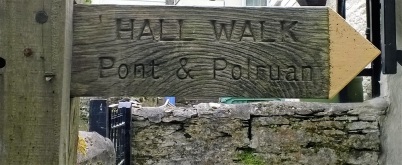
The car park at Boddinick is free but very small. We got the last space, next to a lady with the tiniest baby. Another car arrived: new grandparents to the baby. They were planning a day out together, but the car park was full. A little bit of jigging around and we squeezed out some room for the latest arrival. Rucksacks on our backs, cameras to the ready and we were off, striding with enthusiasm down the hill, past the ferry and Ferryside, and up the steep village street, looking for the signpost where we turned onto the footpath.
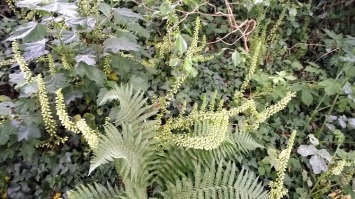
This first footpath is shady and earthy, bordered by plants and ferns.
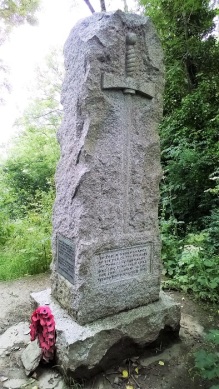
We came to the “Q” monument, erected in tribute to Arthur Quiller-Couch and to local men lost in the World Wars. Q is a Cornishman who looms regularly in my explorations though for the moment he remains as shadowy as the footpath we were taking. One day I’ll embrace him and he’ll step into the light for me. For today it’s enough to know that the land was given to the National Trust as a joint memorial to Quiller-Couch and to the lost men of Fowey and Polruan.
The Hall Walk is so named because it originally ran from Hall Manor, built in the thirteenth century at the top of the village, to Penleath Point on the waterside. There is a descending path from the Q monument to Penleath Point. We didn’t know this at the time which is probably just as well or Karina would have had us clambouring down and of course back up again. There was a lot of climbing to come; I was happy to save that optional descent for another visit.
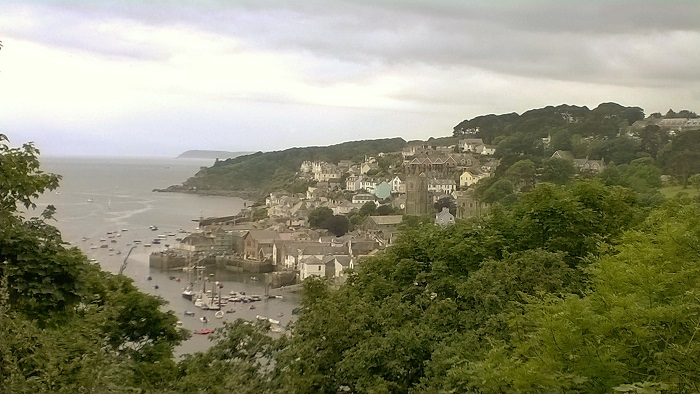
And so the views emerge. Traveling above the finger of creek, we are treated to frequent vistas of Fowey and Polruan and the plethora of tiny craft littering the creek and the estuary. It’s beautiful, even against the nondescript grey skies. Karina is enchanted. There are of course others walking our route, including a party of tourists taking a break on a coach trip. People are friendly, bonded by this common pursuit, and we don’t feel crowded.

I tell her that this was a walk taken in Tudor times. Writing in 1585, Richard Carew described the original Hall Walk thus:
“…cut out in the side of a steepe hill….evenly levelled, to serve for bowling, floored with sand, for soaking up the rayne, closed with two thorne hedges, and banked with sweete senting flowers: It wideneth to a sufficient breadth, for the march of five or sixe in front, and extendeth, to not much lesse, then halfe a London mile …..and is converted on the foreside, into platformes, for the planting of Ordinance, and the walkers sitting; and on the back part, into Summer houses, for their more private retrait and recreation.”
In one of the aforementioned summer houses we find another stone monument which reminds us that King Charles I visited here in 1644 during the English Civil War and narrowly missed being hit by a shot from a musket fired by parliamentary troops stationed across the water in Fowey. Would history have changed significantly had the musket ball found its mark, I wonder?
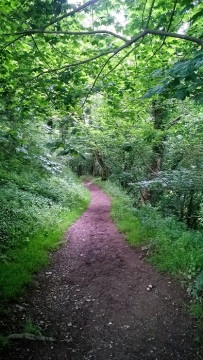
The path turns away from the scenic views over Pont Pill, skirts a field and heads downwards through open woodland. We chat and walk, happy in each other’s company. Nothing too arduous required of me so far. Suddenly we are waterside: we have arrived at Pont, the sleepiest of hamlets. Pont was formerly a thriving quay where barges unloaded coal and limestone. Early in the 19th century lime kilns were built on either side of the creek and what is now Pont Pill Farmhouse used to be an inn frequented by barge crews.
This sign caught my eye, perhaps the most obvious reminder of the life that once was here.
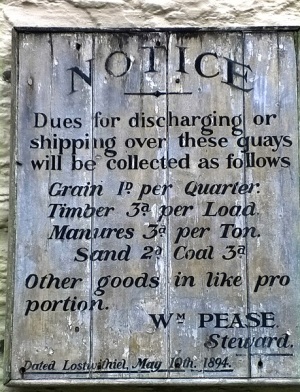
Today Pont is a quiet, picturesque backwater – I suspect its few houses are now all holiday rentals. We cross the stone bridge where the party of tourists have stopped for their picnic lunch. This is where we begin to think about departing from the Hall Walk and embark on Karina’s extra loop.
It’s also where we get lost for a while. After some debate we set off along a promising road, passing this tranquil, deserted water-mill.
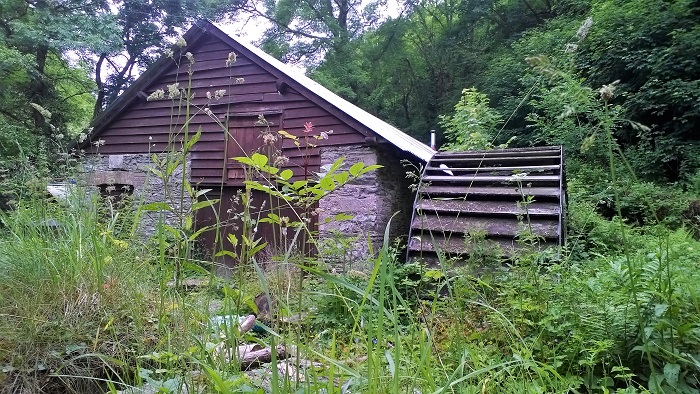
I begin taking photos only to discover that the back may look empty and derelict but from the other side it is very much lived in. I’m not one for boldly photographing people’s houses; I hope the occupants will forgive me. We realise our mistake and retrace our steps, meeting a lone walker making the trek in the opposite direction. We helped each other out a little.
Back on track, the next section of the walk links with Daphne: we begin the climb to Lanteglos church. Daphne was married here, and Jane Slade is buried in the churchyard. Jane was the model for the figurehead Daphne discovered which led to the writing of her first novel, The Loving Spirit. The heroine of that book is based on Jane Slade herself. Daphne and her wedding party travelled by boat up the creek to Pont early on a sunny morning on 19th July 1932. They walked to the church, presumably along the footpath we now followed. It was a fairly steep and muddy climb. I pictured Daphne taking this path in her wedding finery. I wonder what thoughts were passing through her mind: what hopes, dreams and expectations. She probably didn’t huff and puff as much as I did.
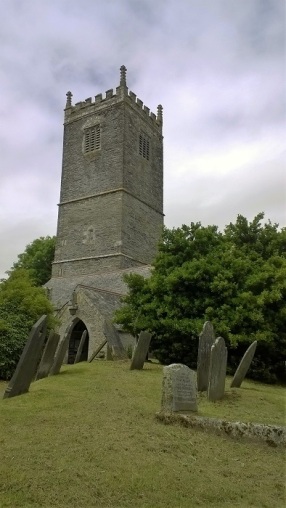
The church is dedicated to St Wyllow, a 6th century Irishman who apparently lived as a hermit in Cornwall and was beheaded by the locals. It shares the same imposing style as its local counterparts: the large square tower dominating the exterior. In The Loving Spirit Daphne calls this Lanoc Church. Somewhere here was Jane Slade’s grave, but the churchyard was overflowing. We wandered around, noting repeated familial names – sometimes whole families of children dying within a few tragic years of each other. Inside the church we enjoyed a drink, which local residents kindly provide for walkers, and we found a key to all of the graves. It was no surprise that Jane Slade’s grave was marked clearly on the plan; I would be one of many who looked for it. The grave was larger than I expected although with hindsight I should not have been surprised: the Slades were a prominent and no doubt prosperous local boat-building family. The inscription was too faint to read but I’m pleased that we found it.
Above us, the skies were clearing. It had been a sticky and humid climb through the dank woods to the church. As the clouds parted and the breeze stirred we were refreshed and ready to press on. At this point the Hall Walk itself turns back along the other side of the creek but we were striking out seaward. We had completed half of the Hall Walk; the remaining half would have to wait for another occasion.
Because now the vertiginous cliffs were calling …

An enchanting (and adventurous) walk…
LikeLiked by 1 person
Woohoo! I’ve never been blogged about before, but what a wonderful and accurate account of that treasured day we spent in a corner of Cornwall. Here’s to more such days!! xxx
P.S. You did very well climbing those vertiginous cliffs 😀
LikeLiked by 1 person
There’s a first time for everything my friend! And I still have the second half of our walk to cover, including the cliffs… and not forgetting the singing in the rain….
LikeLike
I can’t wait! Hahaha!!
LikeLiked by 1 person